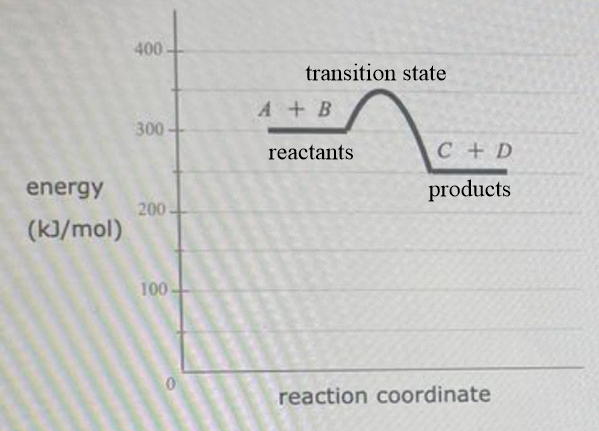Consider a hypothetical chemical reaction: A+B C+D 1 (In this equation A, B, C and D stand for some unknown chemical formulas.) Here is an energy diagram for the reaction: energy (kJ/mol) 400- 300 200 100- A + B C + D reaction coordinate Use the energy diagram to answer these questions. What is the heat of reaction? Is the reaction exothermic or endothermic? Can you determine the activation energy? Can you determine the activation energy of the reverse reaction? C+D+A+B kJ/mol Exothermic O Endothermic ONeither O Yes, it's kJ/mol No. Yes, it's kJ/mol No. X Ś
Consider a hypothetical chemical reaction: A+B C+D 1 (In this equation A, B, C and D stand for some unknown chemical formulas.) Here is an energy diagram for the reaction: energy (kJ/mol) 400- 300 200 100- A + B C + D reaction coordinate Use the energy diagram to answer these questions. What is the heat of reaction? Is the reaction exothermic or endothermic? Can you determine the activation energy? Can you determine the activation energy of the reverse reaction? C+D+A+B kJ/mol Exothermic O Endothermic ONeither O Yes, it's kJ/mol No. Yes, it's kJ/mol No. X Ś
Chemistry
10th Edition
ISBN:9781305957404
Author:Steven S. Zumdahl, Susan A. Zumdahl, Donald J. DeCoste
Publisher:Steven S. Zumdahl, Susan A. Zumdahl, Donald J. DeCoste
Chapter1: Chemical Foundations
Section: Chapter Questions
Problem 1RQ: Define and explain the differences between the following terms. a. law and theory b. theory and...
Related questions
Question

Transcribed Image Text:A
Consider a hypothetical chemical reaction:
A+B C+D
-
(In this equation A, B, C and D stand for some unknown chemical formulas.)
Here is an energy diagram for the reaction:
energy
(kJ/mol)
400-
300-
200-
100
0
A + B
C + D
reaction coordinate
Use the energy diagram to answer these questions.
What is the heat of reaction?
Is the reaction exothermic or endothermic?
Can you determine the activation energy?
Can you determine the activation energy of the reverse reaction?
C+D+A+B
kJ/mol
O Exothermic
Endothermic
Neither
Yes,
No.
No.
it's kJ/mol
it's
Yes, it's
X
it's kJ/mol
S
Expert Solution
Step 1
The progress of a reaction can be represented by the reaction coordinate diagram. In a reaction coordinate diagram, we can easily detect the transition state, activation energy, and intermediate.
Intermediate: The short-lived species which form in between the product and the reactants are known as intermediate.
Transition state: The highest energy species between the reactants and product or intermediate is known as a transition state.

Step by step
Solved in 7 steps with 4 images

Knowledge Booster
Learn more about
Need a deep-dive on the concept behind this application? Look no further. Learn more about this topic, chemistry and related others by exploring similar questions and additional content below.Recommended textbooks for you

Chemistry
Chemistry
ISBN:
9781305957404
Author:
Steven S. Zumdahl, Susan A. Zumdahl, Donald J. DeCoste
Publisher:
Cengage Learning

Chemistry
Chemistry
ISBN:
9781259911156
Author:
Raymond Chang Dr., Jason Overby Professor
Publisher:
McGraw-Hill Education

Principles of Instrumental Analysis
Chemistry
ISBN:
9781305577213
Author:
Douglas A. Skoog, F. James Holler, Stanley R. Crouch
Publisher:
Cengage Learning

Chemistry
Chemistry
ISBN:
9781305957404
Author:
Steven S. Zumdahl, Susan A. Zumdahl, Donald J. DeCoste
Publisher:
Cengage Learning

Chemistry
Chemistry
ISBN:
9781259911156
Author:
Raymond Chang Dr., Jason Overby Professor
Publisher:
McGraw-Hill Education

Principles of Instrumental Analysis
Chemistry
ISBN:
9781305577213
Author:
Douglas A. Skoog, F. James Holler, Stanley R. Crouch
Publisher:
Cengage Learning

Organic Chemistry
Chemistry
ISBN:
9780078021558
Author:
Janice Gorzynski Smith Dr.
Publisher:
McGraw-Hill Education

Chemistry: Principles and Reactions
Chemistry
ISBN:
9781305079373
Author:
William L. Masterton, Cecile N. Hurley
Publisher:
Cengage Learning

Elementary Principles of Chemical Processes, Bind…
Chemistry
ISBN:
9781118431221
Author:
Richard M. Felder, Ronald W. Rousseau, Lisa G. Bullard
Publisher:
WILEY